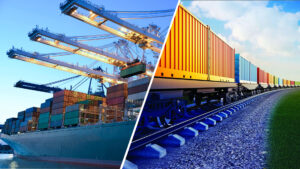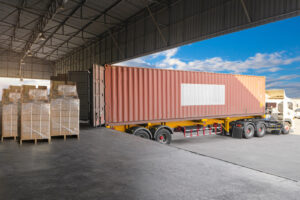This post was last updated on Jan 25th, 2024
There are many benefits to intermodal transportation. It creates jobs in industries that depend on shipping goods and is a cost-effective and efficient means of transporting products across Canada and beyond our borders to the US via cross-border shipping.
But there are some downsides too. Intermodal transport can be noisy and cause air pollution when trucks use diesel fuel. And while trains might be more environmentally friendly than other modes of transportation, they are less flexible because railroad tracks are fixed in one location.
In this blog post, we’ll talk frankly about the cons of intermodal freight transportation and how and when rail intermodal shipping should be considered.
Let’s dive in.
Looking to save on your domestic intermodal shipping across Canada? At RailGateway we have unbeatable rates from Ontario to Alberta. Request a quote today to see just how much we can help you save!
What are the disadvantages of intermodal transportation?
1. Speed
One of the main disadvantages of intermodal transportation is speed. Because intermodal transportation involves moving goods between different modes of transport, it can often take longer than if the goods were transported using only one mode. This is because each time the goods are transferred between modes, there is a risk of delays due to weather, traffic, or other problems.
In addition, intermodal transportation often requires specialised equipment, which can add to the time it takes to load and unload the goods.
2. Lack of reliability between intermodal service providers
In order for intermodal transportation to be successful, there needs to be a high level of reliability between the various service providers. Unfortunately, this is often not the case.
Service providers may be unable to provide the promised level of service, or they may not have the necessary equipment available when it is needed. As a result, intermodal transportation can be less reliable than other methods of transportation, which can lead to delays and additional costs.
In order to improve the reliability of intermodal transportation, service providers need to work together to invest in better coordination and communication.
3. High infrastructure costs
Higher infrastructure costs often cause higher service rates for companies that use intermodal transportation. This is especially true when the use of cranes or other heavy-duty equipment is required to move full-load containers.
Intermodal containers have lowered costs and made it easier for shippers to transport their products by standardizing how they’re packaged, but require they are handled by industrial-sized cranes which could be scarce outside major port cities.
4. The complexity of the intermodal operation
Intermodal transportation is a complex system with many moving parts and without proper service design parameters in place, can become a messy process to clean up afterward.
5. Delivery frequency and intermodal transportation timeliness
Intermodal carriers tend to be less frequent than other types of freight carriers like ground and air. This can cause transportation problems if a customer’s demand is not able to keep up with the limitations of intermodal shipments.
However, with a little planning, a lack of timeliness and urgency can save in the long run.
6. Cargo handling of restricted or prohibited products
Some items are either not allowed to be shipped via intermodal transportation or can only be transported if they’re taken apart and reassembled once reaching their destination.
This makes shipping of hazardous materials difficult, as well as some raw building materials that need to be processed prior to being used on the construction site.
7. Damage during the intermodal shipping process
In most cases, damage can be avoided with proper loading and handling procedures. These procedures can be very difficult to manage in container shipping because of the lack of communication between railcar, yard worker, and truck driver.
Building strong partnerships with the right people is crucial for a successful freight transportation process. When you work together, your shipment will be delivered on time and in good condition!
The best way to minimize risk among all parties involved? Starts by having an engaged intermodal solutions team behind the scenes who knows what they’re doing.
At RailGateway we’ll make sure that everything goes as planned throughout this complex but critical intermodal shipping journey. From origin through to the final destination so that not only are deadlines met, but also customer expectations.
Intermodal transport benefits can often be outweighed by its disadvantages when it comes to damage during the freight shipping process. With the correct logistics company on your side, a single point of contact can help to ensure that everything goes as planned and your freight is delivered on time.
If this sounds like what you’re looking for, contact RailGateway today to get a rail quote today to learn more about how we can help you save.
8. Grievous goods transportation within Canada (environmental hazards)
It’s important to understand that not all dangerous goods are prohibited for transport via road or rail. The rules regarding what hazardous products are allowed vary depending on whether they are transported by highway, rail, or both transport modes.
A product may be allowed for transport as an exception (that means the shipper fills out documentation and seeks permission) if it fits within a series of conditions:
1. The product, although dangerous, has been packaged correctly by the manufacturer;
2. The gross mass of all dangerous products shipped is less than 330 lbs (150kg)
3. It is permitted for transport by other modes of transportation.
4. The dangerous goods being transported are in a quantity or concentration available to the general public.
The two main organizations that regulate the transport of hazardous materials are Transport Canada and the U.S Department of Transportation.
These organizations publish a number of regulations that must be followed in order to safely transport dangerous goods between jurisdictions.
9. Seasonal weather, traffic, congestion, and other environmental factors
Intermodal transportation receives a lot of attention because of concerns about road congestion and traffic safety.
And because infrastructure capacity is limited, traffic flow disruptions (such as collisions, congestion, or road maintenance) might result in delays and complications in any transportation strategy.
Rail infrastructure is becoming increasingly important as the preferred alternative for shipping goods between locations, especially those that require intermodal transport.
It’s easy to see why: trains can move heavy and oversized cargo that would otherwise be unsafe on roads; rail networks are less susceptible to environmental factors such as rain or snow than roadways and they often go through areas that are under-served by road infrastructure.
10. Limited options for smaller shipments
For smaller or LTL (less than truckload) shipments, options for working with an intermodal service provider may be limited.
The smaller the shipment, the less likely it will be that an Intermodal provider will have a candidate to move it. It may require multiple stops, making delivery times more lengthy than FTL options.
However, providers are working hard to provide customers with more flexible service offerings – which is good news for those who need flexibility.
11. Port congestion
Port congestion is a big concern for freight shipping and international trade. Container ships floating waiting for port access, and threats of driver strikes, are all too common in an industry under huge strain due to increased transport costs and a global pandemic.
To improve on this, some providers are offering more innovative transport options, including Intermodal transfers within the port environment itself to maximize terminal space and decongest intermodal container yards.
12. Interference with other modes of transport
Because of their size, Intermodal trains take up a lot of room.
As Intermodal traffic increases, it creates more logistical complexity with railways having to navigate around Intermodal trains on shared lines.
Since Intermodal is so effective at moving goods quickly, this may cause interruptions of other rail services. This can have a negative impact on commercial operations that are reliant on the logistics industry for their deliveries.
13. Concerns about Intermodal service quality
The Intermodal transportation industry could be seen as a price-competitive market; carriers tend to focus on low prices and lower margins in order to win business and stay competitive.
The challenge for Intermodal customers has been positive customer perception and confidence in Intermodal transport delivery standards without negatively impacting cost savings or price competitiveness.
Through innovation in technology, Intermodal carriers have been working hard to raise the customer service standards of Intermodal transportation.
Pros and Cons of Intermodal Transport
Benefits of intermodal freight shipping
There are three major benefits to an intermodal shipment. And the first and foremost is the cost savings.
A further added benefit is sustainability. This is because when one mode of transportation such as rail or ship malfunctions, the other mode will be able to act as backup, thereby reducing any possible damage done to goods.
For a complete list of benefits visit our post ‘Getting Started with Intermodal Transport: The 7 Benefits Beyond What You’ve Heard‘
The downfall of an intermodal transportation system
It is not uncommon for individuals who want to take advantage of the benefits that come with this type of intermodal transportation mode to lose money.
This occurs when there’s a delay in the delivery time of goods or when working with an inexperienced rail transport partner.
With RailGateway as your intermodal freight shipper, you’re guaranteed unparalleled service that saves you money while providing a reliable solution for all of your supply chain needs.
Our extensive network provides a single point of contact to develop the most extensive and comprehensive rail program for our clients. And with over 40 years of combined rail experience are rates are unmatched across Canada.
The Importance of Intermodal Transportation
Besides low transportation costs, fuel efficiency, and the positive environmental impact that rail transportation and intermodal transportation services offer, planning and executing large-scale projects is also a huge plus when considering intermodal shipping.
In 2019, the Canadian rail industry carried more than 332 million tonnes of freight and assisted in the delivery of $205 billion worth of Canadian products to markets all around North America and throughout the world through a network of intermodal terminals (rail, ship, and truck).
With some of the most competitive rail transportation costs in the world, Canadian businesses (and as a happy side-effect, consumers) saved billions of dollars with intermodal freight transportation.
Multimodal Transportation and Intermodal Transport Mode explained
Intermodal freight transport, which combines multiple modes of transit into a single journey, is critical to the delivery process. It enables accurate routing and reduces handling costs.
While only using one carrier can provide the most efficient transportation method while also reducing paperwork, sometimes it’s preferable to use several different transport carriers for optimum overall shipping cost but with greater logistic coordination work.
Multimodal Transportation is the term used to describe the transport of goods using two or more modes. The carriers involved in an intermodal transportation chain should be compatible with each other so that they can deliver items safely and efficiently together. While truckload freight companies are common partners for railroads, truck carriers are also linked with steamships to increase flexibility.
How to Choose the Right Mode of Transport for Your Needs
Intermodal shipping has always been a difficult decision to make. You have to take into account the pros and cons of all transportation modes, including road freight transport, rail, river transportation, and airfreight.
Factors you need to take into account when making the choice between intermodal shipping logistics companies are:
– Availability of raw materials for various modes of transportation.
– Economical properties, fuel efficiency, modal systems of each mode.
– Geographical access of all intermodal providers.
– Security of cargo during the transportation process.
– Ease of logistics.
When making the choice to switch to intermodal freight shipping or rail freight shipping, you need to take into account all the factors above and compare them with the benefits offered by each model.
Before switching to using intermodal freight shipping or rail freight shipping, your company must have a good understanding of the financial aspects of using each model.
For example, if you ship commercially sensitive or high-value shipments that need to be transported quickly, then air freight transport might be best for your business due to its ability to move products at high speeds.
If you’re shipping large quantities of goods, then it might be better for your business to use intermodal rail shipping due to its large capacity which can provide significant savings.
Another important factor when choosing between intermodal shipping and rail freight transportation is the security aspect of transporting your goods.
If your company needs high-security transport, then modes such as sea or road transport might be better than modes such as air transport, where security can sometimes be compromised.
Switching to using intermodal freight shipping or rail freight shipping could benefit your business in many ways.
When should you consider using rail freight for shipping your products across Canada?
Rail freight services are utilized by a wide range of clients and transport a diverse variety of items and commodities. Power generating companies, construction companies, retailers, and fruit wholesalers are all frequent users of rail freight services.
Railways play a strategic role in Canada’s economy and are the most efficient and dependable form of transportation, moving 70% of the nation’s surface goods.
The railways are an important part of Canada’s history and were instrumental in the growth and development of the country. Canada’s geography makes the railways an invaluable resource for moving cargo from one part of the country to another and especially over long distances.
Curious if making the switch to rail is right for your business? Contact one of our RailGateway intermodal shipping experts today for more information on how rail can help reduce costs.
The shipping industry continues to baffle the average consumer. There are so many modes of transportation which makes it hard to determine what mode will be the most cost-efficient, economical, and safe.
The world of intermodal and multimodal transportation is no different. It can be confusing to know what options are available and if they will meet your specific company’s needs.
Choosing the right mode of transport is difficult for any business. If you’re not sure if switching to using either modal service would help improve efficiency in your company, feel free to contact our team of rail experts who are ready and waiting to answer any questions or concerns regarding this topic.
We look forward to hearing from you!December




